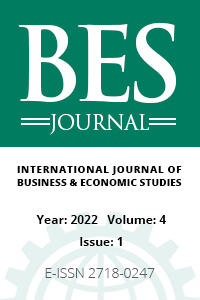Do Sleep Disorders Affect Stock Markets? Evidence from Borsa Istanbul
Bu çalışmanın amacı, 1988-2015 yılları arasında Borsa İstanbu’da faaliyet gösteren hisse senetleri üzerinde yaz saati uygulamasının etkisini araştırmaktır. Bu kapsamda, yaz saati uygulaması anomalisinin saat değişimlerini takip eden gün ve hafta içerisinde hisse senedi getirileri ve volatilite üzerindeki etkisi analiz edilmektedir. Araştırma sonuçları, hisse senedi getirileri ve volatilitenin yaz saati değişikliklerinden etkilenmediğini göstermektedir. Diğer bir ifadeyle, Borsa İstanbul’da yaz saati uygulamasının etkisine dair her hangi bir bulguya rastlanmamıştır.
Anahtar Kelimeler:
Uyku Bozuklukları, , Yaz Saati Uygulaması, , Borsa İstanbul
Do Sleep Disorders Affect Stock Markets? Evidence from Borsa Istanbul
The aim of this study is to investigate the effect of “daylight saving time” (DST) changes on Borsa Istanbul, covering the periods from 1988 to 2015. In this context, daylight saving anomaly was examined by using stock market returns and volatilities following DST changes on daily and weekly basis. The results indicate that both market returns and volatilities following daylight saving time changes do not differ from other days and weeks. Thus, it can be said that there is no evidence of daylight saving time effect in Borsa Istanbul.
Keywords:
Sleep Disorders, Daylight Saving Time, Borsa Istanbul,
___
- BERUMENT, M Hakan, DOĞAN, Nuhket and ONAR, Bahar (2010), “The Effects of Daylight Saving Time Changes on Stock Market Volatility”, Psychological Reports, V. 106(2), pp. 632-640.
- BERUMENT, M Hakan and DOĞAN, Nuhket (2011), “Effects of Daylight Saving Time Changes on Stock Market Volatility: A Reply”, Psychological Reports, V. 109(3), pp. 863-878.
- COREN, Stanley (1996a), Sleep Thieves, New York: Free Press.
- COREN, Stanley (1996b), “Daylight Savings Time and Traffic Accidents”, New England Journal of Medicine, V. 334(14), pp. 924.
- FERNANDO, Antonio, SAMARANAYAKE, Chinthaka Bhagya, BLANK, Christopher J., ROBERTS, Gareth and ARROLL, Bruce (2013), “Sleep Disorders among High School Students in New Zealand”, Journal of Primary Heath Care, V. 5(4), pp. 276-282.
- GERLACH, Jeffrey R. (2010), “Daylight and Investor Sentiment: A Second Look at Two Stock Market Behavioral Anomalies”, Journal of Financial Research, V. 33(4), pp. 429-462.
- GREGORY-ALLEN, Russell, JACOBSEN, Ben and MARQUERING, Wessel (2010), “The Daylight Saving Time Anomaly in Stock Returns: Fact or Fiction?”, Journal of Financial Research, V. 33(4), pp. 403-427.
- ORZEL-GRYGLEWSKA, Jolanta (2010), “Consequences of Sleep Deprivation”, International Journal of Occupational Medicine and Environmental Health, V. 23(1), pp. 95–114.
- KAMSTRA, Mark J, KRAMER, Lisa A. and LEVI, Maurice D. (2000), “Losing Sleep at the Market: The Daylight Saving Anomaly”, American Economic Review, V. 90(4), pp. 1005-1011.
- KAMSTRA, Mark J, KRAMER, Lisa A. and LEVI, Maurice D. (2010), “Effects of Daylight-Saving Time Changes on Stock Market Volatility: A Comment”, Psychological Reports, V. 107(3), pp. 877-887.
- KAMSTRA, Mark J, KRAMER, Lisa A. and LEVI, Maurice D. (2013), “Effects of Daylight-Saving Time Changes on Stock Market Returns and Stock Market Volatility: A Rebuttal”, Psychological Reports: Sociocultural Issues in Psychology, V. 112(1), pp. 89-99.
- KORKMAZ, Turhan, BAŞARAN, Ümit and ÇEVİK, Emrah İsmail (2010), “Yaz Saati Uygulaması Anomalisinin İMKB 100 Endeks Getirisine Etkisinin Test Edilmesi”, Ege Akademik Bakış, V. 10(4), pp. 1139-1153.
- LAMB, Reinhold, ZUBER, Richard A. and GANDAR, John M. (2004), “Don't Lose Sleep on it: A Reexamination of the Daylight Savings Time Anomaly”, Applied Financial Economics, V. 14(6), pp. 443-446.
- MÜLLER, Luisa, SCHIERECK, Dirk, SIMPSON, Marc W. and VOIGT, Christian (2009), “Daylight Saving Effect”, Journal of Multinational Financial Management, V. 19(2), pp. 127-138.
- O’BRIEN, Erin M. and MINDELL, Jodi A. (2005), “Sleep and Risk-Taking Behavior in Adolescents”, Behavioral Sleep Medicine, V. 3(3), pp. 113-133.
- PATEL, J B. (2012), “A Reexamination of the Effect of Daylight Saving Time Changes on U.S. Stock Returns”, Journal of Academy of Business and Economics, V. 12(2), pp. 109-114.
- PINEGAR, J Michael (2002), “Losing Sleep at the Market: Comment”, American Economic Review, V. 92(4), pp. 1251-1256.
- SCHWERT, G William (1989), “Why Does Stock Market Volatility Change Over Time?”, Journal of Finance, V. 44(5), pp. 1115-1153.
- STEIGERWALD, Douglas Gardiner and CONTE, Marc N. (2007), “Do Daylight-Saving Time Adjustments Really Impact Stock Returns?”, University of California at Santa Barbara, Economics Working Paper Series, pp. 1-19.
- VARUGHESE, Jason and ALLEN, Richard P. (2001), “Fatal Accidents Following Changes in Daylight Savings Time: The American Experience”, Sleep Medicine, V. 2(1), pp. 31-36.
- WALLEMO, Daniel (2007), “Daylight Saving Time and Seasonal Affective Disorder - External Factor Influence on Stock Return and Trading Volume”, Master Thesis, Stockholm School of Economics.
- WORTHINGTON, Andrew C. (2003), “Losing Sleep at the Market: An Empirical Note on the Daylight Saving Anomaly in Australia”, Economic Papers, V. 22(4), pp. 83-93.
- ISSN: 2718-0247
- Yayın Aralığı: Yılda 2 Sayı
- Yayıncı: Mesut DOĞAN
Sayıdaki Diğer Makaleler
Entelektüel Sermaye İle Yönetim Kurulu Yapısı Arasindaki İlişki: Tekstil Sektöründe Bir Uygulama
Does Bank Size Affect The Bank Profitability? An Evidence From Borsa Istanbul (BIST), Turkey
Do Sleep Disorders Affect Stock Markets? Evidence from Borsa Istanbul
Hilal Hümeyra ERDOĞAN, Engin KÜÇÜKSİLLE
Altın ve Petrol Fiyatları ile BIST100 Endeksi Arasındaki Nedensellik İlişkisinin İncelenmesi
